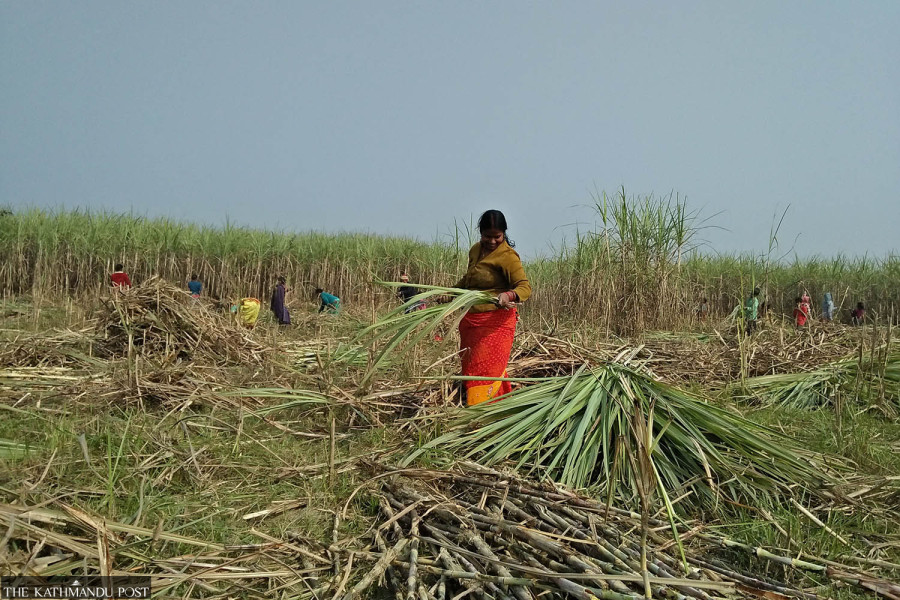Money
Government hikes minimum support price of sugarcane
Thursday’s Cabinet meeting fixed the floor price at Rs585 per quintal, up Rs20. Cane farmers say they are not happy.
Krishana Prasain
The government has fixed the minimum support price for this season’s harvest but sugarcane farmers say they don’t receive that amount.
Thursday’s cabinet meeting fixed sugarcane's minimum support price at Rs585 per quintal, up Rs20 from last year’s price.
“That’s an annual ritual. Sugarcane farmers are compelled to take whatever amount the sugar mills provide them,” said Ashok Prasad Yadav, a farmer from Garuda municipality-2, Rautahat.
“The sugar producers are above the law.”
He said that last year the government fixed the minimum support price at Rs565 per quintal but Baba Baijunath Sugar and Chemical Industries in Rautahat purchased sugarcane at Rs540.
“The government does nothing about it despite farmers’ complaints,” said Yadav.
The farmers in Rautahat sell their cane to Baba Baijunath. Shree Ram Sugar Mill shut down in July 2020 after it could not clear the farmers' dues.
“We have been visiting the District Administrative Office daily to get Rs25 per quintal, which the mill has denied us. There is no response from the government despite sugar mills cheating us,” said Yadav.
The dues owed by Baba Baijunath to farmers are more than Rs40 million for last season's harvest, said Yadav.
“It looks like the government and sugar mill have colluded.”
Sugarcane is the largest commercial cash crop cultivated in Nepal, but sugar producers' non-payment issues have been making headlines for decades. Due to the growing non-payment issue, farmers have switched to other crops.
Yadav, who used to cultivate sugarcane in 15 bighas, has reduced the amount of sugarcane farming by a third.
“Besides the non-payment issue, the rate fixed by the government does not benefit farmers as the cost of fuel, labour, and fertiliser have increased sharply,” said Yadav.
He said he has switched to lentils and fish farming that generates good income.
According to Yadav, who is also president of the Sugarcane Farmer Association, Rautahat district used to produce around 3.2 million quintals of sugarcane, but this has declined to 700,000 quintals.
The farmers have started harvesting sugarcane for this season but are in a dilemma.
Kapil Muni Mainali, president of the Federation of Sugarcane Producers Association, said they have repeatedly demanded that the sugarcane rate be fixed, taking into account the price of sugar.
“Though the government invites us to the meeting before setting the minimum support price, when the rate is announced, it is made in the interest of sugar producers,” he said. “The government policy has not encouraged sugarcane farmers. And this will eventually result in the decline in farming.”
Sugarcane farmers and their associations had demanded that the price be hiked to Rs679 per quintal, excluding the government subsidy of Rs70, but Mainali said the demand was not heeded.
The government announced a cash subsidy scheme in 2018 after the farmers complained that the money they get from the mill owners was insufficient to cover their costs. In Nepal, sugarcane harvest normally begins in mid-November.
The output has been declining annually as farmers’ issues are always overlooked.
In 2019-20, Nepal produced 3.4 million tonnes of sugarcane, which dropped to 3.18 million tonnes in 2020-21, according to the agriculture ministry statistics. In 2021-22, the production further declined to 3.15 million tonnes.
Nepal used to produce 155,000 tonnes of sugar annually until a few years ago but this has now declined to 120,000 tonnes after sugar mill owners failed to pay sugarcane growers on time, according to the Salt Trading Corporation.
Nepal’s annual sugar requirement is around 270,000 tonnes. The deficit is met by imports.
Currently, nine sugar mills are operating. Five have shut down operations.




 8.12°C Kathmandu
8.12°C Kathmandu














